Intel Ghost Canyon NUC9i9QNX Review: NUC 9 Extreme Realizes the SFF Dream
by Ganesh T S on April 16, 2020 8:05 AM ESTBAPCo SYSmark 2018
The Intel NUC9i9QNX (Ghost Canyon) was evaluated using our Fall 2018 test suite for small-form factor PCs. In the first section, we will be looking at SYSmark 2018.
BAPCo's SYSmark 2018 is an application-based benchmark that uses real-world applications to replay usage patterns of business users in the areas of productivity, creativity, and responsiveness. The 'Productivity Scenario' covers office-centric activities including word processing, spreadsheet usage, financial analysis, software development, application installation, file compression, and e-mail management. The 'Creativity Scenario' represents media-centric activities such as digital photo processing, AI and ML for face recognition in photos and videos for the purpose of content creation, etc. The 'Responsiveness Scenario' evaluates the ability of the system to react in a quick manner to user inputs in areas such as application and file launches, web browsing, and multi-tasking.
Scores are meant to be compared against a reference desktop (the SYSmark 2018 calibration system, a Dell Optiplex 5050 tower with a Core i3-7100 and 4GB of DDR4-2133 memory to go with a 128GB M.2 SATA III SSD). The calibration system scores 1000 in each of the scenarios. A score of, say, 2000, would imply that the system under test is twice as fast as the reference system.
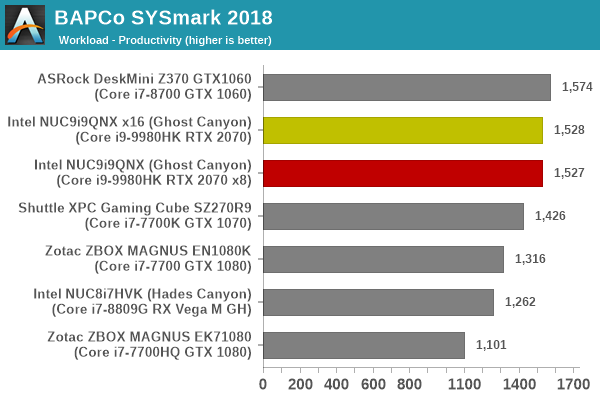
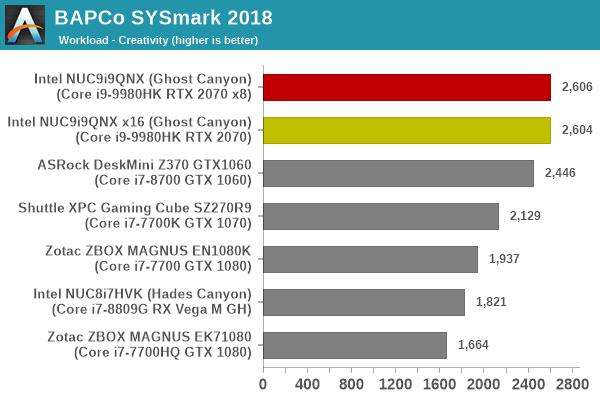
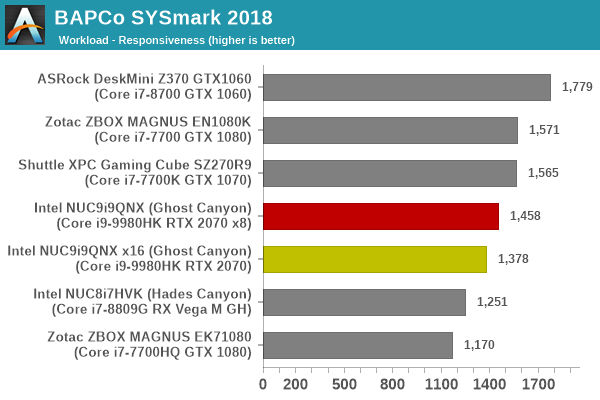
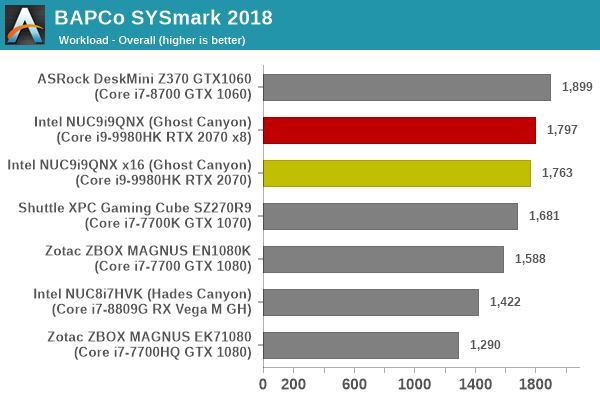
Systems equipped with 65W+ TDP desktop processors get higher scores in most workloads, though only the DeskMini Z370 manages an higher overall rating compared to the NUC9i9QNX. The surprising result is the responsiveness score for the two Ghost Canyon configurations - having the Optane drive talk directly to the CPU without the DMI bottleneck makes the system significantly more responsive.
SYSmark 2018 also adds energy measurement to the mix. A high score in the SYSmark benchmarks might be nice to have, but, potential customers also need to determine the balance between power consumption and the efficiency of the system. For example, in the average office scenario, it might not be worth purchasing a noisy and power-hungry PC just because it ends up with a 2000 score in the SYSmark 2014 SE benchmarks. In order to provide a balanced perspective, SYSmark 2018 also allows vendors and decision makers to track the energy consumption during each workload. In the graphs below, we find the total energy consumed by the PC under test for a single iteration of each SYSmark 2018 workload. For reference, the calibration system consumes 5.36 Wh for productivity, 7.71 Wh for creativity, 5.61 Wh for responsiveness, and 18.68 Wh overall.

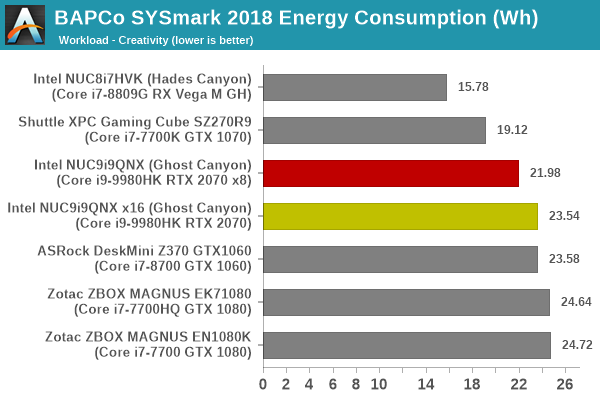
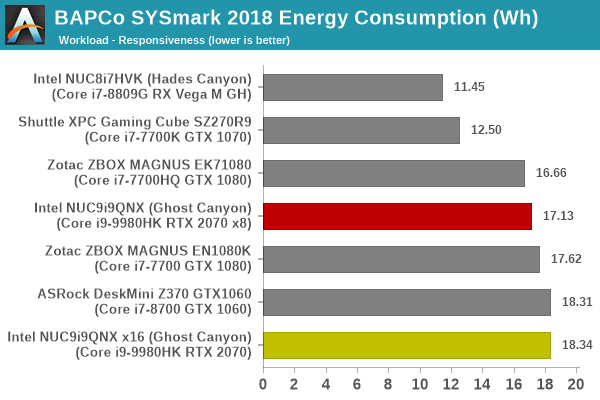
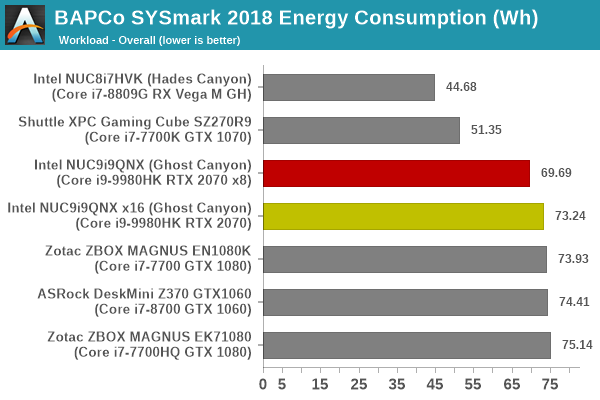
The NUC9i9QNX is hobbled slightly by the power-hungry Optane drive and high-TDP discrete GPU, making it approach the other desktop CPU-based systems in the list when the overall energy consumption is considered. Compared to a x16 configuration, operating the GPU at x8 results in lowered energy consumption for the SYSmark 2018 workloads.










109 Comments
View All Comments
buckiller - Thursday, April 16, 2020 - link
Power pig. Hades Canyon was great, but this is hot trash, relative to expectations set by last-gen and perf/power capabilities that are possible today.> The Ghost Canyon NUC9i9QNX is a SFF enthusiast's dream come true.
Ooph. Hardly.
Dolda2000 - Thursday, April 16, 2020 - link
I have to admit that I still don't really see the point of this system. It seems that its main gimmick is the fact that what is essentially the motherboard plugs into a PCIe riser card. That's fine and useful and all, but PCIe riser boards and cables are nothing new, and I don't really see what this does that hasn't already been doable for quite some time. You can replace the compute element? Sure, but being able to replace motherboards is nothing new to most form factors. Please do enlighten me if I'm missing something.Dragonstongue - Thursday, April 16, 2020 - link
the series adds the ability for end-users to add a standard PCIe video card to the system system.to the system's system ... or just to the system..
as for folks complain about the price, CPU alone is ~580 USD .. RTX 2070 mini ~539
so there is over $1k right there
I personally wouldn't be buying NUC "overall" based on should be Ryzen A and B absolutely not given seems Intel is "up to their same old BS tricks" via "preventing" folks from offering AMD based options available...
Destoya - Thursday, April 16, 2020 - link
$580 CPU, you have to be kidding. Nobody, including OEMs, pays the tray MSRP intel has listed.If you want to look at it in terms of value, it has the same performance as a Ryzen 3600 ($175)...
Deicidium369 - Thursday, April 16, 2020 - link
First off, there are no OEMs, it is single source Intel. I love Intel NUCs - not sure what the use case for this model is.Namisecond - Friday, April 17, 2020 - link
I don't think Intel manufactures those CPU cards (soldered BGA CPUs). They're probably integrated by a 3rd party OEM like Foxxcon. It's one thing to have engineering samples, but for Intel to step into the motherboard manufacturing game requires a lot of capital resources...unless the NUC parts are actually going to be made at Intel's engineering labs...If it's a production run in the 10Ks...that just might be feasible.Deicidium369 - Friday, April 17, 2020 - link
And like I said there are no OEMs available for you to buy from - single source - Intel. I thought I saw something a few years ago about possibly PNY - I know they do the Nvidia branded graphics cards.BlazingDragon - Thursday, April 16, 2020 - link
The article is misleading... and very Intel biased, IMHO.The ~$1500 USD price is for the i9 barebones kit only... just compute element [w/CPU], daughter board and PSU - i.e. not including a GPU, DRAM memory or SSD - that's why it's so outlandish...
Good ITX m/board & Ryzen 3900x CPU, plus really nice case and PSU is << $900 USD.
Deicidium369 - Thursday, April 16, 2020 - link
So a review of a product from Intel is very Intel biased.... That has to be a huge conspira-plotBlazingDragon - Thursday, April 16, 2020 - link
A review of anything can be positive or negative on that thing... and is unbiased if it seems balanced and fair in that criticism [be it positive or negative].If said article seems to over exaggerate the positives, and/or misrepresent them, and miss out or under call some of the negatives, then yes, it's biased... and IMHO, that's exactly what this article does...